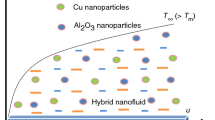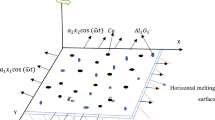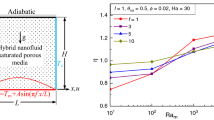Abstract
The impact and capability of Cu–Al\(_2\)O\(_3\)/water nanoliquid as the heat transfer fluid are numerically investigated along a moving surface with melting heat transfer. The reduced differential equations are solved and presented in the figures and tables. The percent error between present and previous numerical values is 0% which supports the model validation. The volumetric concentration of both Al\(_2\)O\(_3\) and Cu nanoparticles is chosen at most 4% to avoid the instability of the nanofluid. The dual solutions are only seen when the external flow and solid surface move in an opposite direction. Remarkably, the use of hybrid nanofluid assists the boundary layer separation in the presence of melting heat transfer. However, the heat transfer rate of Cu–Al\(_2\)O\(_3\)/water is inevitably greater than the pure water and Cu–water. An increase in melting parameter reduces the heat transfer rate and accelerates the separation of boundary layer. The stability analysis supports the initial hypothesis from the graphical results that the second solution is unstable.







Similar content being viewed by others
Abbreviations
- A :
-
Surface area of the heat transfer (\(\text {m}^{2}\))
- \(f(\eta )\) :
-
Dimensionless stream function
- h :
-
Heat transfer coefficient (\(\text {W}\,\text{m}^{-2}\,\text {K}^{-1}\))
- k :
-
Fluid thermal conductivity (\(\text {W}\,\text{m}^{-1}\,\text {K}^{-1}\))
- \(q_{\text{w}}\) :
-
Surface heat flux (\(\text {W}\,\text{m}^{-2}\))
- \(s_1\) :
-
First solid nanoparticle (Alumina/Al\(_2\)O\(_3\))
- \(s_2\) :
-
Second solid nanoparticle (Copper/Cu)
- t :
-
Time (s)
- u, v :
-
Velocity components along the x, y directions, respectively (\(\text {m}\,\text{s}^{-1}\))
- x, y :
-
Cartesian coordinates
- \(C_{\text{f}}\) :
-
Skin friction coefficient
- \(C_{\text{p}}\) :
-
Specific heat at constant temperature (\(\text {J}\,\text{kg}^{-1}\,\text {K}^{-1}\))
- \(\left( \rho C_{\text{p}}\right)\) :
-
Heat capacity of the fluid (\(\text {J}\,\text{K}^{-1}\,\text {m}^{-3}\))
- Me:
-
Melting parameter
- Nb:
-
Brownian motion parameter
- Nt:
-
Thermophoresis parameter
- \(Nu_{\text{x}}\) :
-
Local Nusselt number
- \(\text {Pr}\) :
-
Prandtl number
- \({\text{Re}}_{\text{x}}\) :
-
Local Reynolds number
- T :
-
Fluid temperature (K)
- \(T_{0}\) :
-
Temperature of the solid surface (K)
- \(T_{\text{m}}\) :
-
Melting surface temperature (K)
- \(T_{\infty }\) :
-
Ambient temperature (K)
- \(U_{\text{w}}\) :
-
Velocity of the moving surface (\(\text {m}\,\text{s}^{-1}\))
- \(U_\infty\) :
-
Free stream velocity (\(\text {m}\,\text{s}^{-1}\))
- \(\lambda\) :
-
Moving parameter
- \(\eta\) :
-
Similarity variable
- \(\psi\) :
-
Stream function
- \(\theta\) :
-
Dimensionless temperature
- \(\mu\) :
-
Dynamic viscosity (\(\text {kg}\,\text{m}^{-1}\,\text {s}^{-1}\))
- \(\nu\) :
-
Kinematic viscosity (\(\text {m}^2\,{\text {s}^{-1} }\))
- \(\rho\) :
-
Fluid density (\(\text {kg}\,{\text {m}^{-3} }\))
- \(\gamma\) :
-
Eigenvalue
- \(\gamma _1\) :
-
Smallest eigenvalue
- \(\tau\) :
-
Dimensionless time variable
- \(\tau _{\text{w}}\) :
-
Wall shear stress (\(\text {kg}\,\text{m}^{-1}\,\text {s}^{-2}\))
- \(\phi _1,\phi _2\) :
-
Volumetric concentration for first nanoparticle and second nanoparticle, respectively
- f:
-
Base fluid
- nf:
-
Nanofluid
- hnf:
-
Hybrid nanofluid
References
Moutsoglou A, Bhattacharya AK. Laminar and turbulent boundary layers on moving, nonisothermal continuous flat surfaces. J Heat Transf. 1982;104:707–14.
Sakiadis BC. Boundary layer behavior on continuous solid surfaces. II: the boundary layer on a continuous flat surface. AIChE J. 1961;7:221–5.
Modi VJ, Fernando MS, Yokomizo T. Moving surface boundary-layer control-studies with bluff bodies and application. AIAA J. 1991;29(9):1400–6.
Weidman PD, Kubitschek DG, Davis AMJ. The effect of transpiration on self-similar boundary layer flow over moving surfaces. Int J Eng Sci. 2006;44(11–12):730–7.
Merkin JH. On dual solutions occurring in mixed convection in a porous medium. J Eng Math. 1986;20(2):171–9.
Ishak A, Nazar R, Bachok N, Pop I. Melting heat transfer in steady laminar flow over a moving surface. Heat Mass Transf. 2010;46:463–8.
Epstein M. The effect of melting on heat transfer to submerged bodies. Lett Heat Mass Transf. 1975;2:97–104.
Epstein M, Cho DH. Melting heat transfer in steady laminar flow over a flat plate. J Heat Transf. 1976;98:531–3.
Dogonchi AS, Sheremet MA, Ganji DD, Pop I. Free convection of copperwater nanofluid in a porous gap between hot rectangular cylinder and cold circular cylinder under the effect of inclined magnetic field. J Therm Anal Calorim. 2019;135(2):1171–84.
Abro KA, Chandio AD, Abro IA, Khan I. Dual thermal analysis of magnetohydrodynamic flow of nanofluids via modern approaches of CaputoFabrizio and AtanganaBaleanu fractional derivatives embedded in porous medium. J Therm Anal Calorim. 2019;135(4):2197–207.
Ma Y, Mohebbi R, Rashidi MM, Manca O, Yang Z. Numerical investigation of MHD effects on nanofluid heat transfer in a baffled U-shaped enclosure using lattice Boltzmann method. J Therm Anal Calorim. 2019;135(6):3197–213.
Ma Y, Mohebbi R, Rashidi MM, Yang Z. MHD forced convection of MWCNTFe 3 O 4/water hybrid nanofluid in a partially heated T-shaped channel using LBM. J Therm Anal Calorim. 2019;136(4):1723–35.
Sheikholeslami M, Sheremet MA, Shafee A, Li Z. CVFEM approach for EHD flow of nanofluid through porous medium within a wavy chamber under the impacts of radiation and moving walls. J Therm Anal Calorim. 2019;138:573–81.
Sheikholeslami M, Jafaryar M, Shafee A, Babazadeh H. Acceleration of discharge process of clean energy storage unit with insertion of porous foam considering nanoparticle enhanced paraffin. J Cleaner Prod. 2020;261:121206.
Khanafer K, Vafai K. Applications of nanofluids in porous medium. J Therm Anal Calorim. 2019;135(2):1479–92.
Okonkwo EC, Wole-Osho I, Almanassra IW, Abdullatif YM, Al-Ansari T. An updated review of nanofluids in various heat transfer devices. J Therm Anal Calorim. 2020;. https://doi.org/10.1007/s10973-020-09760-2.
Shafee A, Sheikholeslami M, Jafaryar M. Numerical modeling of turbulent behavior of nanomaterial exergy loss and flow through a circular channel. J Therm Anal Calorim. 2020;. https://doi.org/10.1007/s10973-020-09568-0.
Hsiao KL. Stagnation electrical MHD nanofluid mixed convection with slip boundary on a stretching sheet. Appl Therm Eng. 2016;98:850–61.
Hsiao KL. Micropolar nanofluid flow with MHD and viscous dissipation effects towards a stretching sheet with multimedia feature. Int J Heat Mass Transf. 2017;112:983–90.
Hsiao KL. Combined electrical MHD heat transfer thermal extrusion system using Maxwell fluid with radiative and viscous dissipation effects. Appl Therm Eng. 2017;112:1281–8.
Hsiao KL. To promote radiation electrical MHD activation energy thermal extrusion manufacturing system efficiency by using Carreau-Nanofluid with parameters control method. Energy. 2017;130:486–99.
Sundar LS, Sharma KV, Singh MK, Sousa AC. Hybrid nanofluids preparation, thermal properties, heat transfer and friction factora review. Renew Sust Energ Rev. 2017;68:185–98.
Sarkar J, Ghosh P, Adil A. A review on hybrid nanofluids: recent research, development and applications. Renew Sust Energ Rev. 2015;43:164–77.
Jana S, Salehi-Khojin A, Zhong WH. Enhancement of fluid thermal conductivity by the addition of single and hybrid nano-additives. Thermochim Acta. 2007;462(1–2):45–55.
Suresh S, Venkitaraj KP, Selvakumar P, Chandrasekar M. Synthesis of Al2O3Cu/water hybrid nanofluids using two step method and its thermo physical properties. Colloid Surf A-Physicochem Eng Asp. 2011;388(1–3):41–8.
Suresh S, Venkitaraj KP, Selvakumar P, Chandrasekar M. Effect of Al2O3Cu/water hybrid nanofluid in heat transfer. Exp Therm Fluid Sci. 2012;38:54–60.
Sidik NA, Adamu IM, Jamil MM, Kefayati GH, Mamat R, Najafi G. Recent progress on hybrid nanofluids in heat transfer applications: a comprehensive review. Int Commun Heat Mass Transf. 2016;78:68–79.
Xian HW, Sidik NAC, Saidur R. Impact of different surfactants and ultrasonication time on the stability and thermophysical properties of hybrid nanofluids. Int Commun Heat Mass Transf. 2020;110:104389.
Sajid MU, Ali HM. Thermal conductivity of hybrid nanofluids: a critical review. Int J Heat Mass Transf. 2018;126:211–34.
Farhana K, Kadirgama K, Rahman MM, Noor MM, Ramasamy D, Samykano M, Najafi G, Sidik NAC, Tarlochan F. Significance of alumina in nanofluid technology. J Therm Anal Calorim. 2019;138(2):1107–26.
Devi SA, Devi SS. Numerical investigation of hydromagnetic hybrid CuAl2O3/water nanofluid flow over a permeable stretching sheet with suction. Int J Nonlin Sci Numer Sim. 2016;17(5):249–57.
Devi SS, Devi SA. Heat transfer enhancement of CuAl2O3/water hybrid nanofluid flow over a stretching sheet. J Nigerian Math Soc. 2017;36(2):419–33.
Rostami MN, Dinarvand S, Pop I. Dual solutions for mixed convective stagnation-point flow of an aqueous silicaalumina hybrid nanofluid. Chin J Phys. 2018;56(5):2465–78.
Waini I, Ishak A, Pop I. Unsteady flow and heat transfer past a stretching/shrinking sheet in a hybrid nanofluid. Int J Heat Mass Transf. 2019;136:288–97.
Waini I, Ishak A, Pop I. Hybrid nanofluid flow induced by an exponentially shrinking sheet. Chin J Phys. 2020;. https://doi.org/10.1016/j.cjph.2019.12.015.
Khashi’ie NS, Arifin NM, Nazar R, Hafidzuddin EH, Wahi N, Pop I. Magnetohydrodynamics (MHD) axisymmetric flow and heat transfer of a hybrid nanofluid past a radially permeable stretching/shrinking sheet with joule heating. Chin J Phys. 2020;64:251–63.
Lund LA, Omar Z, Raza J, Khan I. Magnetohydrodynamic flow of CuFe\(_3\)O\(_4\)/H\(_2\)O hybrid nanofluid with effect of viscous dissipation: dual similarity solutions. J Therm Anal Calorim. 2020;. https://doi.org/10.1007/s10973-020-09602-1.
Lund LA, Omar Z, Khan I, Seikh AH, Sherif ES, Nisar KS. Stability analysis and multiple solution of CuAl\(_2\)O\(_3\)/H\(_2\)O nanofluid contains hybrid nanomaterials over a shrinking surface in the presence of viscous dissipation. J Mater Res Technol. 2020;9(1):421–32.
Aly EH, Pop I. MHD flow and heat transfer near stagnation point over a stretching/shrinking surface with partial slip and viscous dissipation: hybrid nanofluid versus nanofluid. Powder Technol. 2020;. https://doi.org/10.1016/j.powtec.2020.03.030.
Aly EH, Pop I. MHD flow and heat transfer over a permeable stretching/shrinking sheet in a hybrid nanofluid with a convective boundary condition. Int J Numer Methods Heat Fluid Flow. 2019;29(9):3012–38.
Khashi’ie NS, Arifin NM, Pop I, Nazar R, Hafidzuddin EH, Wahi N. Three-dimensional hybrid nanofluid flow and heat transfer past a permeable stretching/shrinking sheet with velocity slip and convective condition. Chin J Phys. 2020;. https://doi.org/10.1016/j.cjph.2020.03.032.
Khashi’ie NS, Arifin NM, Pop I, Nazar R, Hafidzuddin EH, Wahi N. Thermal Marangoni flow past a permeable stretching/shrinking sheet in a hybrid Cu–Al. Sains Malays. 2020;49(1):211–22.
Khashi’ie NS, Arifin NM, Pop I, Wahid NS. Flow and heat transfer of hybrid nanofluid over a permeable shrinking cylinder with Joule heating: a comparative analysis. Alex Eng J. 2020;. https://doi.org/10.1016/j.aej.2020.04.048.
Khashi’ie NS, Arifin NM, Pop I, Nazar R, Hafidzuddin EH, Wahi N. Flow and heat transfer past a permeable power-law deformable plate with orthogonal shear in a hybrid nanofluid. Alex Eng J. 2020;. https://doi.org/10.1016/j.aej.2020.05.029.
Khashiie NS, Arifin NM, Pop I. Mixed convective stagnation point flow towards a vertical Riga Plate in hybrid Cu–Al\(_2\)O\(_3\)/Water Nanofluid. Mathematics. 2020;8(6):912.
Acharya N, Mabood F. On the hydrothermal features of radiative Fe\(_3\)O\(_4\)graphene hybrid nanofluid flow over a slippery bended surface with heat source/sink. J Therm Anal Calorim. 2020;. https://doi.org/10.1007/s10973-020-09850-1.
Mabood F, Yusuf TA, Khan WA. CuAl\(_2\)O\(_3\)H\(_2\)O hybrid nanofluid flow with melting heat transfer, irreversibility analysis and nonlinear thermal radiation. J Therm Anal Calorim. 2020;. https://doi.org/10.1007/s10973-020-09720-w.
Dinarvand S. Nodal/saddle stagnation-point boundary layer flow of CuOAg/water hybrid nanofluid: a novel hybridity model. Microsyst Technol. 2019;25(7):2609–23.
Aladdin NA, Bachok N, Pop I. Cu–Al\(_2\)O\(_3\)/water hybrid nanofluid flow over a permeable moving surface in presence of hydromagnetic and suction effects. Alex Eng J. 2020;59(2):657–66.
Waini I, Ishak A, Pop I. Flow and heat transfer of a hybrid nanofluid past a permeable moving surface. Chin J Phys. 2020;. https://doi.org/10.1016/j.cjph.2020.04.024.
Tiwari RK, Das MK. Heat transfer augmentation in a two-sided lid-driven differentially heated square cavity utilizing nanofluids. Int J Heat Mass Transf. 2007;50(9–10):2002–18.
Mabood F, Shafiq A, Hayat T, Abelman S. Radiation effects on stagnation point flow with melting heat transfer and second order slip. Results Phys. 2017;7:31–42.
Brinkman HC. The viscosity of concentrated suspensions and solutions. J Chem Phys. 1952;20(4):571.
Xuan Y, Li Q. Investigation on convective heat transfer and flow features of nanofluids. J Heat Transf. 2003;125(1):151–5.
Garnett JM. Colours in metal glasses and in metallic films. Philos Trans Roy Soc Lond Ser A. 1904;203(359–371):385–420.
Oztop HF, Abu-Nada E. Numerical study of natural convection in partially heated rectangular enclosures filled with nanofluids. Int J Heat Fluid Flow. 2008;29(5):1326–36.
Krammer P, Vogel H. Hydrolysis of esters in subcritical and supercritical water. J Supercrit Fluids. 2000;16(3):189–206.
Ma Y, Rashidi MM, Mohebbi R, Yang Z. Investigation of magnetohydrodynamics in Ag-TiO\(_2\)/water hybrid nanofluid in a Shamse knot shaped cavity. Int J Numer Methods Heat Fluid Flow. 2020;. https://doi.org/10.1108/HFF-12-2019-0909.
Harris SD, Ingham DB, Pop I. Mixed convection boundary-layer flow near the stagnation point on a vertical surface in a porous medium: Brinkman model with slip. Transp Porous Media. 2009;77(2):267–85.
Waini I, Ishak A, Pop I. On the stability of the flow and heat transfer over a moving thin needle with prescribed surface heat flux. Chinese J Phys. 2019;60:651–8.
Khashi’ie NS, Arifin NM, Rashidi MM, Hafidzuddin EH, Wahi N. Magnetohydrodynamics (MHD) stagnation point flow past a shrinking/stretching surface with double stratification effect in a porous medium. J Therm Anal Calorim. 2020;139:3635–48.
Khashi’ie NS, Arifin NM, Nazar R, Hafidzuddin EH, Wahi N, Pop I. A stability analysis for magnetohydrodynamics stagnation point flow with zero nanoparticles flux condition and anisotropic slip. Energies. 2019;12(7):1268.
Turkyilmazoglu M. Analytical solutions to mixed convection MHD fluid flow induced by a nonlinearly deforming permeable surface. Commun Nonlin Sci Numer Simul. 2018;63:373–9.
Acknowledgements
The financial support from Ministry of Higher Education (Malaysia) through the Fundamental Research Grant Scheme (FRGS5540309) is deeply appreciated including the facilities from Universiti Putra Malaysia and Universiti Teknikal Malaysia Melaka. The authors also appreciate the good comments from the competent reviewers which surely improve the quality of this work.
Author information
Authors and Affiliations
Corresponding author
Additional information
Publisher's Note
Springer Nature remains neutral with regard to jurisdictional claims in published maps and institutional affiliations.
Rights and permissions
About this article
Cite this article
Khashi’ie, N.S., Md Arifin, N., Pop, I. et al. Melting heat transfer in hybrid nanofluid flow along a moving surface. J Therm Anal Calorim 147, 567–578 (2022). https://doi.org/10.1007/s10973-020-10238-4
Received:
Accepted:
Published:
Issue Date:
DOI: https://doi.org/10.1007/s10973-020-10238-4




